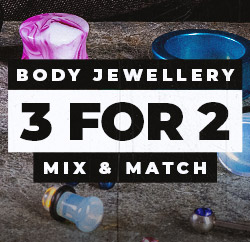When it comes to piercing aftercare, it’s important to remember that there are many different varieties of piercings and that they will all have their own way of healing. You must also consider that piercings can and will heal very differently from person to person and even piercing to piercing so never assume that because you had one experience that all of your subsequent piercings will behave in the same way.
With this in mind, we have compiled a range of aftercare tips for a range of piercings and the relevant best care practices. Regardless of what piercing you've got, it's important to bear these three points in mind:
- NEVER twist or rotate your body jewellery, particularly in the case of cartilage piercings as this will irritate the piercing site and extend the healing period.
- NEVER touch your piercing unless you've washed your hands and spend as little time as possible touching it.
- NEVER use soap or any alcohol-based cleansing products on your piercing, as they are designed to eradicate bacteria. Such harsh cleansers will consequently remove 'good' bacteria produced by your body to help your piercing to heal and will extend the healing period, as well as irritating your open wound.
Immediately following any form of body piercing, you may experience some swelling, bleeding, or weeping. This is a normal part of the body's healing process, though if you feel you're suffering from an abnormal reaction to the piercing, please seek medical attention immediately.
Some swelling can be classed as a 'keloid', however, it should be noted that not all lumps are keloids, some can simply be side effects of the healing process. If keloids or any other form of lumps develop during healing then return to the store for advice.
If you would like to see detailed information about the aftercare of an individual piercing then please visit our piercing sections, linked below:
Ear Piercings
- Auricle
- Anti-Tragus
- Conch
- Daith
- Forward Helix
- Helix
- Industrial / Scaffold
- Lobe
- Orbital
- Pinna
- Rook
- Scapha / Flat
- Snug / Anti-Helix
- Spiral / Triple Helix
- Lobe Stretching
- Tragus
Nose Piercings
Lip Piercings
- Angel Bites
- Ashley
- Canine Bites
- Cyber Bites
- Dahlia Bites
- Dolphin Bites
- Jestrum
- Labret
- Madonna
- Medusa
- Monroe
- Shark Bites
- Snake Bites
- Spider Bites
- Vertical Labret
- Viper Bite
Oral Piercings
Surface Piercings
Genital Piercings
Other Piercings
General Piercing Care
This guide is suitable for anyone with the following piercings:
- Ear (lobe or any ear cartilage piercing)
- Nose (nostril, septum or bridge)
- Surface (navel, eyebrow, skin diver, microdermal, etc)
To keep your piercing looking and feeling tip-top, we recommend following this procedure:
- Wash your hands with antibacterial soap and hot water before touching your piercing.
- Next, using a solution of rock salt and pre-boiled, slightly cooled water (1 part salt to 4 parts water), clean your piercing. This can be done by either fully submerging the piercing fully or by applying the solution liberally to the piercing and the surrounding areas with a cotton bud or pad. A great tip is to use a shot glass or a small bowl to submerge your piercing.
- If you notice any fluid or crust, ensure you remove it gently using the solution and cotton buds or pads. If there is any kind of stubborn build-up then you may need to repeat the cleansing process until you've removed all the build-up.
- Gently pat the area dry with a non-fibrous paper towel. Never use toilet paper or cosmetic tissues, as they can leave material residue behind.
- Finally, check that your jewellery is secure. Ensure threaded balls or screw on balls are on correctly and wash your hands again.
Do this twice a day for the advised healing time of your piercing.
In addition to keeping your piercing clean, it's essential to monitor its overall 'health'. If you notice any lumps, bumps or issues with migration, it's important to seek advice from a qualified piercer, who will be able to recommend a course of action to treat the issue. If you experience abnormal bleeding, weeping, or pain, you should seek medical attention immediately.
Oral Piercing Care
This guide is recommended for anyone with the following piercings:
- Lip (labret, bites, Monroe, etc)
- Tongue
- Oral (smiley, frowny, etc)
To keep your piercing healthy and clean, we advise following this procedure:
- Wash your hands with antibacterial soap and hot water before touching your piercing.
- Using a solution of rock salt and pre-boiled, slightly cooled water (1 part salt to 4 parts water), clean your piercing by swishing the solution around your mouth for 15-3. seconds. Spit out the solution once you're done.
- Finally, check that your jewellery is secure. Ensure threaded balls or screw on balls are on correctly and wash your hands again. Do this 2-3 times a day for the advised healing time of your piercing. It's also recommended to rinse your mouth after eating with an alcohol-free mouthwash.
For lip and cheek piercings it's important to clean the front of the piercing twice a day following the General Piercing Care Guide and clean the back of your piercing following the Oral Piercing Care Guide to maintain high standards of hygiene.
It's essential to keep a close eye on your general dental health when you have an oral piercing as well as looking out for any of the general piercing problems such as lumps. Replace your toothbrush on a regular basis (every 3 months), attend regular dental appointments, and regularly floss your teeth to keep your mouth in tip-top shape.
Pro Pierce Ultimate Piercing Aftercare Solution
To help your piercing heal efficiently and effectively add the Pro Pierce Ultimate Piercing Aftercare Solution to your aftercare regime. Use twice a day to gently cleanse your piercing and soothe your skin. Simply follow the instructions on the bottle to use this ear piercing aftercare solution as part of your piercing aftercare. This specially formulated aftercare solution contains properties such as:
- Cleansing Antimicrobial: Keep your piercing clean from any unwanted bacteria.
- Skin-Neutral pH: This gentle formula will help to prevent skin irritation.
- Dermatologist Tested: Pro Pierce Aftercare uses ingredients that are kind to skin.
- Accelerated Skin Recovery: Help your piercing to heal successfully by adding the Pro Pierce Aftercare Solution to your cleaning routine.
- Vegan-Friendly and Cruelty-Free: Not tested on animals and mindful of the planet.
- Fragrance and Alcohol Free: Using only a short list of essential ingredients.
Please Note: The Pro Pierce Ultimate Piercing Aftercare Solution is designed for external use only so please DO NOT use to clean oral piercings.
Tea Tree Oil For Healing Piercings
Tea tree oil is a great product to use if you are experiencing a reaction from your body modification. This can be used as well as a saltwater solution to clean the piercing.
Tea tree oil originates from Australia and was used a great deal during WW2 for its natural healing properties. As an anti-septic, it has excellent penetrative qualities because the oil naturally permeates deeper into the wound, especially when used on a piercing.
This is the aftercare product of choice for many because of its natural properties that won’t aggravate the piercing area. Many make the mistake of using harsher products on their new body modification thinking that it will remove the bacteria and, whilst this is true, alcohol and peroxide will also kill the body’s natural bacteria which can extend the healing time considerably as well as dry out or damage the skin around the area.
Not only is tea tree oil great for piercing aftercare but it also has impressive properties with hypertrophic scarring. If you have a healed piercing that exhibits scarring then tea tree oil can be very helpful for reducing and easing the skin around the piercing. It has also been reported that tea tree oil is helpful for bumps that appear around the piercing, both during the immediate aftercare and once the piercing has healed.
Tea tree oil should always be diluted as, at its full strength, it may irritate your skin and can in some rare cases lead to dermatitis. Dilute with distilled water for skin piercings and if you want to use it to gargle for tongue/ lip piercings then use one drop per average-sized glass of water. If too much is ingested, tea tree oil can cause dizziness, nausea, and disorientation as it is a mildly toxic substance.
This is very much a case of listening to your body and using what works for you. You can always return to your piercer if you experience any unusual reactions after using tea tree oil. In the rare event that you have a severe allergic reaction seek medical attention immediately. If you feel uncertain about using tee tree oil, don’t forget that many find salt soaks and saline solution just as helpful.
If you would like further detailed information about caring for your piercing, don’t forget to check out our individual pages for each piercing for specific advice.
Please Note: Blue Banana piercing information is based on knowledge from our experiences as one of the UK's top piercing studios. All details provided should be read alongside professional advice. Please see our full Piercing Articles Disclaimer, here.
























